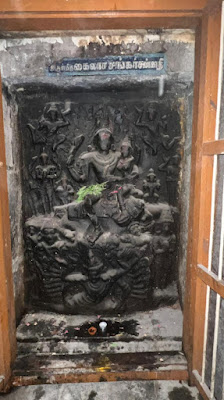Ravana lifting Kailasa - Tirunelveli Nellaiyappar Temple
You may find yourself as a casual observer, perhaps not inclined to delve into the intricacies of sculptures. Alternatively, you might be accompanied by your playful child, whose attention might not be drawn to the temple's details. However, in both cases, what I'm about to describe demands attention. It's a spectacle of magnificence, an embodiment of grandeur that cannot be overlooked.
Resuming my narrative within the Kantimati Sameta Nellaiyappar temple in Tirunelveli, I now transition from the southern second prakara to the western second prakara, encircling the revered Nellaiyappar sanctum.
Directing my gaze to the southwest, a location known as Kanni Moolai, I anticipate encountering the familiar Kanni Moola Ganapati shrine. Yet, this time, the norm is broken. What captures my attention is a striking statue of Ravana. Ravana, depicted here, commands attention with his imposing presence – large, substantial, and profound.
His figure embodies both ferocity and complexity. With ten heads and twenty arms, he stands as a symbol of his multifaceted nature. Amidst these many arms, he brandishes an array of weapons, signifying his prowess as a warrior. But it doesn't end there – Ravana's skills as an artist come to light as well, as he plays the Veena. And then, there's the iconic act that defines him – lifting the mountain, Kailasa. This portrayal of strength and determination is made tangible as he lifts the celestial abode with ease. The celestial beings, animals, and sages adorning the mountain appear minuscule in comparison, further emphasizing his colossal size.
In this stunning stucco image of Ravana, we are presented with an intriguing lesson that goes beyond the pages of the Ramayana. The sculpture becomes a living narrative, allowing us to grasp the essence of Ravana's character without needing to read or hear his tale.
But the intrigue doesn't stop there. The mountain Ravana hoists is no ordinary mount; it is Kailasa, abode of Lord Shiva. Ascending the steps flanking Ravana, we arrive at a shrine atop the symbolic Kailasa. Here, a monumental sculpture of Shiva takes center stage, accompanied by his consort Uma and their infant Skanda. The representation of Somaskanda in such grandeur invites reflection. It's a nod to the Pallava style that inspired the Nayakas, a testament to the enduring influence of artistic heritage across centuries and lands.
As I stand before this awe-inspiring portrayal, grappling with the weight of its symbolism, I find myself needing time to digest the marvel that narrates the story of Ravana and his Kailasa feat. In my subsequent post, I shall continue the journey, unraveling the splendor of other shrines and sculptures within this prakara.
Lacking a photograph of this specific depiction of Ravana lifting Kailasa, I've opted to share an image portraying a smaller representation of the same scene, both of which originate from the temple itself.
 |
| Photo courtesy - Vijay Bhat |
Happy travelling.
This article is Part 22 of the series of articles I write about Kantimati Sameta Nellaiyappar Temple.
The other parts of the series can be accessed through the below-listed links.


.JPG)
Comments
Post a Comment